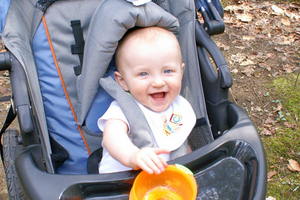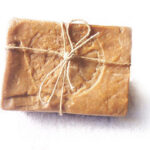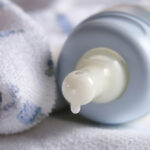As your baby grows, around 7-9 months, he or she will start to be able to eat finger foods in addition to formula or breastmilk and baby food purees. Starting finger foods can often be stressful for parents since choking is always a major fear. You baby needs to learn to feed himself, however, and providing finger foods is the only way to get him started. Here are some great ideas for first finger foods to try with your baby.
First of all, always feed your baby in a seated position and supervise her while she eats. When you first start offering finger foods, offer only one or two pieces at a time. Little hands that lack fine motor skills are likely to grab an entire handful of food if give the opportunity. Be prepared for your baby to take some time learning how to get the food from his fingers to his mouth. He will likely grab the food very quickly, but may take some time to understand the pathway to his mouth. Also, babies tend to throw their fingers or thumbs into their mouths along with the finger foods. This is normal, especially for babies who are finger or thumb suckers and may last for some time.
Now you need to make the decision as to what finger foods to offer your baby. There are a few commercial products that make excellent first finger foods. Gerber, as well as some other manufacturers, create a product called fruit and vegetables puffs. These cereal-like, crunchy puffs made from real fruits or vegetables are easy for little fingers to grasp, and they dissolve very quickly in your baby’s mouth. The only disadvantage to these puffs is their lack of nutritional value. They also contain a very small amount of added sugar. As an occasional snack, however, they make for a great first finger food.
Another great option as a first finger food for your baby is overcooked vegetables or fruits. When vegetables and fruits are overcooked they get very soft and will be easily mashed between a baby’s gums. Cut the veggies into very small pieces and offer just one or two pieces at a time. Make sure you prepare your vegetables and fruit with no added salt or sugar and test the temperature before offering it as a finger food. If you would like to spice up your finger foods, you can use some spices such as nutmeg, cinnamon, basil, ginger, garlic powder, mint, dill, and rosemary.
A third excellent first finger food is whole grain toast. Choose a bread that is whole grain, but that has a fine texture. There are some whole grain white breads available that work great. Toast your bread so that it may be ripped into very small pieces, and so that it does not get stuck in your baby’s mouth or throat. Just as with the cooked fruits and vegetables, make sure your test the temperature of this finger food before offering it.
As your baby starts to master eating finger foods, you can branch out with what you offer her. Just make sure that the food is soft enough to be mashed with the gums (even if your baby has some teeth), is easy to grasp by little fingers, and is okay to feed your baby at his particular age. There are a few specific foods that are known to be choking hazards including whole grapes, large pieces of meat or cheese, popcorn, raisins, peanut butter, celery, fruit roll-ups, and seeds or pits.
Learning to self-feed by trying finger foods can be a fun and exciting time for both you and your baby. Try these tips to keep both your mind at ease and your baby’s tummy full.




